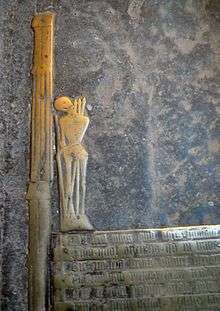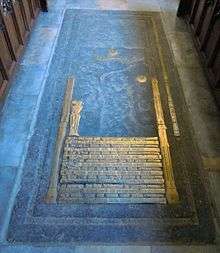Monumental brass of John Rudying

The monumental brass of John Rudying is a brass of 1481 to Archdeacon John Rudying in the Church of St Andrew in Biggleswade in Bedfordshire noted for the surviving Figure of Death.
Archdeacon John Rudying
In the centre of the floor of the chancel in St Andrew's church are the remains of a "very remarkable"[1] monumental brass to Archdeacon John Rudying (died 1481) who is said to have rebuilt or refurnished the chancel of the church at his own expense in about 1470.[2] Rudying held a large number of ecclesiastical offices, many of them simultaneously, including Prebend of Biggleswade in Lincoln Cathedral, Archdeacon of Bedford, Vicar of St Michael the Archangel in Gloucester, Archdeacon of Stow, Archdeacon of Northampton and Archdeacon of Lincoln.[3] Despite all these pluralist offices Rudying clearly chose to be buried in St Andrew's in Biggleswade by setting down so large a tomb; however, he is actually buried in Buckingham.[4]
Memento mori

The monument's brass has a Latin inscription between the lost figure of Rudying and the Figure of Death who is about to strike Rudying with a spear.[5][6] The brass is "in the tradition of the memento mori in that, despite Rudying's self-proclaimed accomplishments, Death points out that all men come to the same end."[1]
Scholarly history
This is the same memorial that was said to have been destroyed during the restoration of St Andrew's Church in 1870. The archaeologist Herbert Haines (1861) described the brass as lying in a large Purbeck Marble slab in the middle of the chancel, being 11½ ft by 5½ ft with the effigy of Archdeacon Rudying and the canopy with Saints John the Baptist, Anna, Elizabeth, and Mary of Egypt being destroyed. The figures of Death and angels and a Latin inscription in sixteen Latin verses and a largely damaged marginal inscription in ten Latin verses survived. He added that the slab was decorated with crescents and escallops of which only two survive.[7][8] The lost figure of Archdeacon Rudying was originally kneeling before Death.[9]
The antiquarian Richard Gough in his epic work The Sepulchral Monuments of Great Britain gave an entire page to the monument in his second volume, illustrating it in a drawing by Jacob Schnebbelie and the engraving by Barak Longmate.[10]
Nikolaus Pevsner in his The Buildings of England: Bedfordshire, the County of Huntingdon and Peterborough (1968) states that the surviving brass fragments on the monument were found in 1955 after a fire in the church caused the damaged tiles on the chancel floor to be lifted, revealing the tomb below.[4][11]
References
- 1 2 Church of St Andrew, Biggleswade on the English Heritage Listed Buildings website
- ↑ St Andrew's Church on the Biggleswade History Society Timeline
- ↑ Philip Rutt, Biggleswade Parish Church: The Building and Its History (2011) p12
- 1 2 Rutt, p13
- ↑ Cartlidge, Neil, A debate with death : John Rudyng's Brass in St Andrew's Church, Biggleswade, Transactions of the Monumental Brass Society., 19 (2) (2015) pp. 94-100 - University of Durham
- ↑ Brass Monumental Brass of Death and John Rudying - Rubbings Collection - Ashmolean Museum, University of Oxford
- ↑ 'A Brass once in Biggleswade Church' - The Antiquaries Journal, Volume 16, Issue 3 (1936) pp. 284-290
- ↑ H. Haines, A Manual of Monumental Brasses, published under the sanction of the Oxford Architectural Society, Oxford, 1848; 2nd edit., 2 vols. Oxford, 1861; reprinted Bath (1970)
- ↑ Sir A. W. Franks, Proceedings of The Society of Antiquaries, vi, p311
- ↑ R. Gough, The Sepulchral Monuments of Great Britain, 5 vols., London (1786-99)
- ↑ Nikolaus Pevsner, The Buildings of England: Bedfordshire, the County of Huntingdon and Peterborough, (1968) p 55